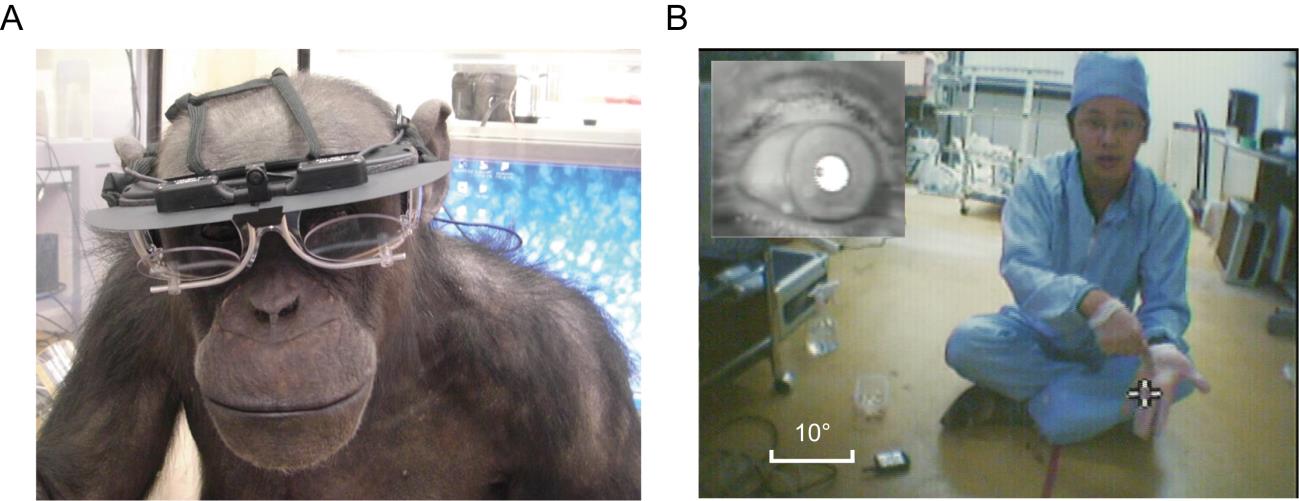頭部装着型の視線計測装置、すなわちウェアラブル・アイ・トラッカーをチンパンジーに応用することに初めて成功した
Head-Mounted Eye Tracking of a Chimpanzee under Naturalistic Conditions
Fumihiro Kano, Masaki Tomonaga
DOI: 10.1371/journal.pone.0059785概要
チンパンジーはどのように世界を見ているのだろうか? 今回、この疑問に文字通り直接迫ることのできる技術―頭部装着型の視線計測装置、すなわちウェアラブル・アイ・トラッカーをチンパンジーに応用することに成功した。チンパンジーはヒトに最も近い動物で、チンパンジーとヒトの視線の相違を調べることによって、ヒトの知覚や注意の進化的基盤(ヒトのユニーク性やチンパンジーとの類似性)に迫ることができると期待される。
ウェアラブル・アイ・トラッカー
この装置には、小型軽量のカメラが三つついていて、一つは頭の上から目の前のシーンをとらえる。二つは両目の動きをとらえる。目の動きから、見ている方向を計算して、頭の上からとらえた目の前のシーンの上に見ている場所を表示する仕組みになっている(図1・右)。装置を頭にかぶったヒトあるいはチンパンジーが今現在どこを見ているのかリアルタイムに記録することができる。
チンパンジーの視点から見た世界
もともとこの装置は、大型のデスク型視線計測装置を軽量化し装着できるようにすることで、人が日常的に環境に働きかけ、働きかけられる中で、どのように視線を用いているのか調べるために開発された(たとえば運転中や球技運動中の視線計測)。私たちはこの装置をチンパンジーに応用した。従来の心理研究のように特定の実験課題をチンパンジーに課すのではなくて、チンパンジーの日常的な視点をとらえるから、彼らに何ができるかというよりも、彼らが何をするのかという、個体の「自発性」に迫ることができる点が革新的だ。
今回の研究では、チンパンジーが日常的に研究者や飼育者とかかわる中で、どこを見ているのかを定量化した。実験では、まず実験者が小部屋にチンパンジーと一緒に入り、視線装置を装着させる。その後、別の実験者が小部屋の外で、カメラの角度などの確認・調整をする。次に、特定の場所数か所にチンパンジーの注意を惹き、記録される視線と実際の視線の位置調整(キャリブレーション)をする。
調整が終わると、実験場面を作り、視線の記録に移る。実験場面ではまず、実験協力者(飼育者、研究者、チンパンジーにとって見知らぬ人、等々)がドアの陰から姿を現し、チンパンジーに挨拶する。この時実際多くの場合、チンパンジーも体を揺らしたり、特有のあいさつ声(パント・グラント)を上げたりして挨拶を返していた。その後しばらくして、協力者はチンパンジーがいつも研究者と行っているジェスチャー真似ゲームを行う。
実験から分かったことを要約する。第一に、チンパンジーは視線の向け方を、時と場合に応じて柔軟に変化させた。たとえば、実験協力者が現れた直後は、協力者の顔と足を交互に見た。ゲームが始まると、その手がかり(顔や手)を見た。また、ゲームが始まる前は、ゲームで使う果物のご褒美をほとんど見なかったのだが、ゲームが始まるとすぐに頻繁に見始めた。これらの結果は、チンパンジーが状況の変化を素早く良く理解することを示している。第二に、チンパンジーは協力者との普段の経験によって、協力者の見方を変えた。なじみの研究者がいつものように実験室に入ってくるときはあまり視線を向けなかったが、なじみの研究者でも、普段は実験室に入ってこないような人であれば、より頻繁に視線を向けた。予測されるように、見知らぬ人が実験室に入ってきた場合が、一番頻繁に視線を向けた場合である。第三に、チンパンジーが示した視線パターンの多くの特徴は、デスク型視線計測装置を用いた先行研究の結果とよく一致していた。これは私たち研究者にとってうれしい結果だ。頭部装着型装置はその方法でしか調べられない多くのことがあるが、何分計測に手間がかかるため、より簡便な方法で得た結果の裏付けを取るのに適している。
研究の発展
この最初の研究では、一個体のチンパンジーを対象とした。当然、科学的信頼性のために、将来的に個体数を増やす必要がある。現在は二個体のチンパンジーが参加に協力してくれている。研究の方向性は大きく二つに分かれる。一つは、(個体数を増やしたうえで)チンパンジーとヒトの目の動き―情報の取得の仕方―が日常場面でどのように異なるのか調べること。もう一つは、チンパンジーが他者と実際にふれあう中で、どのように駆け引き―他者の動きを予測―するか調べること。
図1

アイ・トラッカーを装着するチンパンジーのパン(左)と、アイ・トラッカーがとらえた眼球の画像と頭の上からの視点画像(右)。十字は目が見ている場所を示す。
Abstract
This study offers a new method for examining the bodily, manual, and eye movements of a chimpanzee at the micro-level. A female chimpanzee wore a lightweight head-mounted eye tracker (60 Hz) on her head while engaging in daily interactions with the human experimenter. The eye tracker recorded her eye movements accurately while the chimpanzee freely moved her head, hands, and body. Three video cameras recorded the bodily and manual movements of the chimpanzee from multiple angles. We examined how the chimpanzee viewed the experimenter in this interactive setting and how the eye movements were related to the ongoing interactive contexts and actions. We prepared two experimentally defined contexts in each session: a face-to-face greeting phase upon the appearance of the experimenter in the experimental room, and a subsequent face-to-face task phase that included manual gestures and fruit rewards. Overall, the general viewing pattern of the chimpanzee, measured in terms of duration of individual fixations, length of individual saccades, and total viewing duration of the experimenter’s face/body, was very similar to that observed in previous eye-tracking studies that used non-interactive situations, despite the differences in the experimental settings. However, the chimpanzee viewed the experimenter and the scene objects differently depending on the ongoing context and actions. The chimpanzee viewed the experimenter’s face and body during the greeting phase, but viewed the experimenter’s face and hands as well as the fruit reward during the task phase. These differences can be explained by the differential bodily/manual actions produced by the chimpanzee and the experimenter during each experimental phase (i.e., greeting gestures, task cueing). Additionally, the chimpanzee’s viewing pattern varied depending on the identity of the experimenter (i.e., the chimpanzee’s prior experience with the experimenter). These methods and results offer new possibilities for examining the natural gaze behavior of chimpanzees.